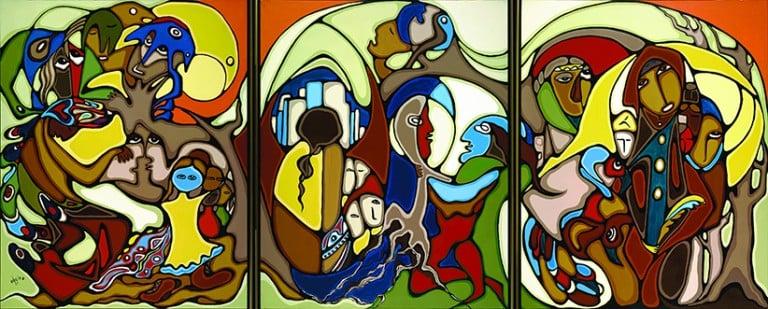‘We want the biggest damned painting you can do’
Daphne Odjig, celebrated Aboriginal painter, on her epic masterpiece

“The Indian in Transition” made Odjig the most celebrated Aboriginal artist in Canada
Share
“We want the biggest damned painting you can do.” When the commissioner at the Canadian Museum of Civilization sent Daphne Odjig this request, he got a four-part mural the height of a bunk bed and the length of two canoes. One of the paintings that has made Daphne the most celebrated Aboriginal artist in Canada, The Indian in Transition (1978), tells a story spanning generations and treaties, persecution and hope. The making of the work was also an epic.
[widgets_on_pages id=”110-back”]
First, to paint it, Daphne had to rent a bigger house. Fifty-nine years old at the time, she then had to haul eight-foot canvases between table and easel, carry full cans of paint with one hand and shinny up a ladder with the other. From the top rungs, she would later drop a bucket that splattered paint across the bottom of her piece, leading to weeks of stress as she incorporated each speckle of the wayward acrylic into an already ambitious project. “Nobody knows the exasperation I went through for that painting,” she says. When a truck arrived to move the final product, a carpenter had to hack away at the door frame so the painting could fit through the exit. Once outside, the first canvas caught a gust of wind. “It started to fly like a kite,” Daphne remembers.
The Indian in Transition eventually made it to Ottawa, where its potent colours and flowing shapes interest thousands of eyes each year. Many of Daphne’s other works also use expressionist and woodland styles to tell Aboriginal stories, and have been featured in museums as far away as Japan, in documentaries by the National Film Board, and on Canadian postage stamps. Among the recognitions on Daphne’s palette are the Governor General’s Award in Visual and Media Arts and being named a member of the Order of Canada.
In childhood, Daphne was an aspiring teacher. When she fell ill with rheumatic fever in Grade 7, she had to quit school and stay home at the family dairy farm on the Wikwemikong Reserve in Ontario. Her grandfather was a stone carver who she followed around each day, leading her to spend hours sketching on the porch.
After moving to Toronto and changing her last name to avoid racism, Daphne worked in multiple factories, salting peanuts and packaging dog food. She briefly considered a career in flamenco dancing, but, after marrying a soldier, focused on raising her son and stepson. When the boys napped, Daphne studied art books and visited galleries, quietly but intensely teaching herself how to paint.

Moving to Winnipeg in the 1960s for her husband’s posting, Daphne opened the first gallery owned by an Aboriginal Canadian, and co-founded a party of painters known as the Indian Group of Seven. In salon-style meetings, the artists discussed how they could be taken more seriously and soon created group exhibits across the country. They also critiqued each other’s work, sometimes for kicks. Daphne remembers joking with sketch-artist Alex Janvier. “I would tell him his drawings looked like road maps.” These lighter shades of personality reflect in some of her work. She once travelled to Jerusalem to paint pamphlets for an airline company, seizing the chance to ride on camels.
Now in Penticton, B.C., Daphne lives in long-term care. She no longer paints but continues to sketch “when the mood hits,” drawing whatever she feels or sees, like those childhood days on the porch. — Meagan Campbell
(Portrait by Jimmy Jeong)
[widgets_on_pages id=”1910s”]
[widgets_on_pages id=”110-post”]